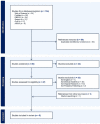Predatory publishing in medical education: a rapid scoping review
- PMID: 38183007
- PMCID: PMC10770935
- DOI: 10.1186/s12909-024-05024-x
Predatory publishing in medical education: a rapid scoping review
Abstract
Background: Academic publishing is a cornerstone of scholarly communications, yet is unfortunately open to abuse, having given rise to 'predatory publishers'- groups that employ aggressive marketing tactics, are deficient in methods and ethics, and bypass peer review. Preventing these predatory publishers from infiltrating scholarly activity is of high importance, and students must be trained in this area to increase awareness and reduce use. The scope of this issue in the context of medical students remains unknown, and therefore this sought to examine the breadth of the current literature base.
Methods: A rapid scoping review was undertaken, adhering to adapted PRISMA guidelines. Six databases (ASSIA, EBSCO, Ovid, PubMed, Scopus, Web of Science) were systematically searched for content related to predatory publishing and medical students. Results were single-screened, facilitated by online reviewing software. Resultant data were narratively described, with common themes identified.
Results: After searching and screening, five studies were included, representing a total of 1338 students. Two predominant themes- understanding, and utilisation- of predatory publishers was identified. These themes revealed that medical students were broadly unaware of the issue of predatory publishing, and that a small number have already, or would consider, using their services.
Conclusion: There remains a lack of understanding of the threat that predatory publishers pose amongst medical students. Future research and education in this domain will be required to focus on informing medical students on the issue, and the implication of engaging with predatory publishers.
Keywords: Information literacy; Publishing; Review; Students; Undergraduate.
© 2024. The Author(s).
Conflict of interest statement
The author declares no competing interests.
Figures

Similar articles
-
Blacklists and Whitelists To Tackle Predatory Publishing: a Cross-Sectional Comparison and Thematic Analysis.mBio. 2019 Jun 4;10(3):e00411-19. doi: 10.1128/mBio.00411-19. mBio. 2019. PMID: 31164459 Free PMC article.
-
Predatory conferences: a systematic scoping review.BMJ Open. 2022 Nov 30;12(11):e062425. doi: 10.1136/bmjopen-2022-062425. BMJ Open. 2022. PMID: 36450423 Free PMC article.
-
False gold: Safely navigating open access publishing to avoid predatory publishers and journals.J Adv Nurs. 2018 Apr;74(4):809-817. doi: 10.1111/jan.13483. Epub 2017 Nov 17. J Adv Nurs. 2018. PMID: 29047152
-
Research on Predatory Publishing in Health Care: A Scoping Review.Can J Nurs Res. 2023 Dec;55(4):415-424. doi: 10.1177/08445621231172621. Epub 2023 May 3. Can J Nurs Res. 2023. PMID: 37138512
-
Defining predatory journals and responding to the threat they pose: a modified Delphi consensus process.BMJ Open. 2020 Feb 9;10(2):e035561. doi: 10.1136/bmjopen-2019-035561. BMJ Open. 2020. PMID: 32041864 Free PMC article.
Cited by
-
[Scientific fraud and dubious publication practices].Med Klin Intensivmed Notfmed. 2025 Aug 7. doi: 10.1007/s00063-025-01307-3. Online ahead of print. Med Klin Intensivmed Notfmed. 2025. PMID: 40772966 Review. German.
-
Factors associated with scientific production citations in dentistry: Zero-inflated negative binomial regression and hurdle modelling.F1000Res. 2023 Oct 12;12:1321. doi: 10.12688/f1000research.141422.1. eCollection 2023. F1000Res. 2023. PMID: 38973941 Free PMC article.
-
Getting Your First Publication in Medical Education-Why? What? Where? How?J Med Educ Curric Dev. 2024 Apr 1;11:23821205241242217. doi: 10.1177/23821205241242217. eCollection 2024 Jan-Dec. J Med Educ Curric Dev. 2024. PMID: 38572089 Free PMC article.
-
"The Best Home for This Paper": A Qualitative Study of How Authors Select Where to Submit Manuscripts.Perspect Med Educ. 2024 Sep 9;13(1):442-451. doi: 10.5334/pme.1517. eCollection 2024. Perspect Med Educ. 2024. PMID: 39290445 Free PMC article.
References
-
- Boukacem-Zeghmouri C, Pergola L, Castaneda H. Profiles, motives and experiences of authors publishing in predatory journals: OMICS as a case study. 2023.
Publication types
MeSH terms
LinkOut - more resources
Full Text Sources

